Age Restriction Fairness: Laws, Policies, and Equal Opportunity
Updated On: November 13, 2025 by Aaron Connolly
Core Principles of Age Restriction Fairness
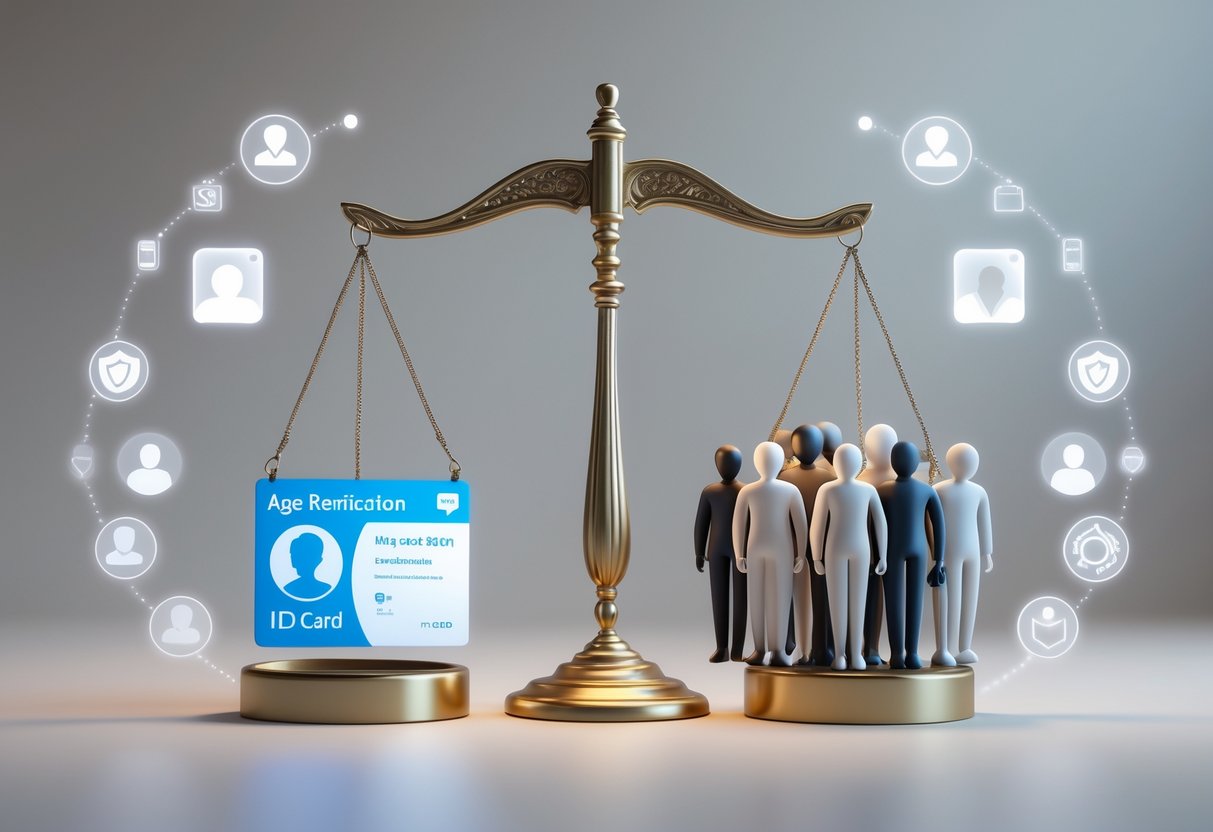
Age restriction fairness tries to protect vulnerable people while avoiding unjust discrimination in jobs, education, and social programs.
This whole framework depends on having clear legal reasons and applying age-based rules consistently.
Defining Age Restriction Fairness
Age restriction fairness means using age-based rules only when they make sense and don’t put up pointless barriers.
Fair age restrictions aim to keep people safe or make sure they have the right skills. Like, minimum driving ages exist to protect public safety.
Everyone in the same age group faces the same rules.
Unfair age restrictions, though, just block people for no good reason. Usually, these come from stereotypes instead of real needs or abilities.
Key elements of fair age restrictions:
- A clear reason for the age limit
- Rules that apply the same way to everyone
- Regular checks to see if the rule is still needed
- Flexibility for individual situations if it makes sense
The legal system understands that sometimes age distinctions matter. But they have to pass certain tests to avoid being discriminatory.
Purpose and Justifications
Legal age restrictions need to have a specific, legitimate purpose or they don’t hold up under federal law.
Main reasons you’ll see:
| Purpose | Examples | Legal Basis |
|---|---|---|
| Safety protection | Minimum driving age, alcohol purchase | Public health standards |
| Developmental readiness | School enrollment ages | Educational requirements |
| Vulnerability protection | Employment restrictions for minors | Child labour laws |
| Program effectiveness | Senior-specific benefits | Statutory objectives |
Employment discrimination laws say job age restrictions must tie directly to what the job actually needs. Employers can’t just use age as a lazy filter.
The Age Discrimination Act of 1975 lets programs use age distinctions if they’re needed for “normal operation.” So, the age limit has to be essential for the program to work.
Programs sometimes use age restrictions to reach certain legal goals. Youth employment programs, for example, obviously focus on younger people.
Key Legal Concepts
A few main legal ideas shape how we decide if age restrictions are fair or legal.
The burden of proof actually falls on the group using the age restriction. They have to show the age limit really serves a legitimate purpose and there’s no better way to meet that goal.
Federal law allows reasonable factors other than age. These must connect directly to the program or job. Think about physical fitness tests for firefighters—they’re fine, even if they affect older applicants more.
Age as a proxy measure sometimes works if it’s too hard to test the real trait for every person. Still, the age cutoff should closely match what’s actually needed.
Employment discrimination protections usually start at age 40, but some programs go broader. The big question is whether the age rule is crucial for business or safety.
Programs that get federal funds face tougher rules. They have to prove their age restrictions fit the law or are really necessary for running the program.
United States Legal Framework for Age Restrictions
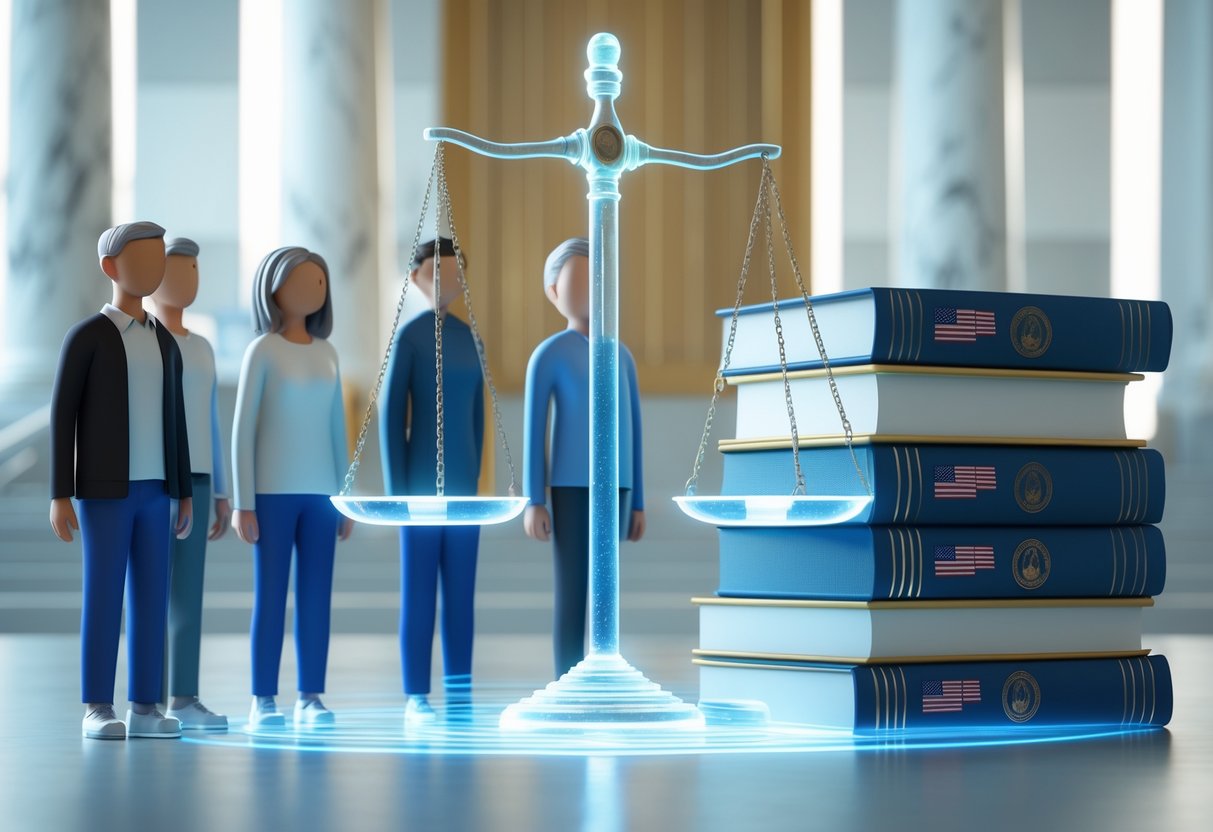
The U.S. has built a pretty tangled web of federal, state, and local laws that control age restrictions in all sorts of areas.
Federal laws like the Age Discrimination in Employment Act set a baseline, but states often add stricter or different rules.
Major Federal Laws
The Age Discrimination in Employment Act (ADEA) is the main federal law protecting people from age discrimination.
Congress passed it in 1967 to protect workers 40 and older from unfair hiring, firing, promotions, and other job decisions.
The ADEA covers everything from pay and job assignments to training, benefits, and work conditions. Employers can’t treat older workers differently just because of their age.
Key protections under the ADEA:
- Hiring and firing
- Promotions
- Pay and benefits
- Access to training
- How layoffs are decided
The law also bans age-based harassment. If someone makes constant or severe comments about age, that can create a hostile workplace and legal trouble.
Congress has expanded the ADEA over time. At first, it only protected workers up to age 70. In 1978, they raised it to 70, then dropped the upper limit for most jobs in 1986.
The Age Discrimination Act of 1975 goes further. It bans age discrimination in any program that gets federal money, and it covers everyone, not just people over 40.
State and Local Regulations
A lot of states created their own age discrimination laws that go further than federal law.
Some states protect younger workers, too, filling gaps the ADEA leaves.
State laws often tackle things the federal government skips, like housing discrimination, public accommodations, or special rules for younger employees.
Some common state differences:
- Lower age cutoffs (protecting people under 40)
- Rules for housing and public access
- Bigger penalties for violations
- Broader definitions of discrimination
Local governments sometimes pass their own age-related rules. These usually deal with housing, public services, or businesses in their area.
Some states allow certain age restrictions that federal law doesn’t. For example, some housing communities legally keep out younger people if they follow federal and state rules.
Exceptions and Variations
Not every age restriction breaks discrimination laws. Courts admit that some age limits actually serve a real purpose.
Bona fide occupational qualifications let employers set age limits when age truly matters for job performance. Airlines, for instance, can require pilots to retire at a certain age for safety.
Public safety jobs often come with age restrictions. Police, firefighters, and air traffic controllers sometimes face mandatory retirement ages, and courts usually accept those.
Age-restricted communities are another exception. Housing developments can keep out younger residents if they meet Fair Housing Act rules, like having 80% of units filled by someone over 55.
The law also allows policies that hit all ages the same, even if they affect older workers more. But employers need to show these policies are for real business reasons, not just age bias.
Typical legal age restrictions:
| Area | Typical Age Limits | Legal Basis |
|---|---|---|
| Employment (certain roles) | Varies by job | Safety needs |
| Housing communities | 55+ or 62+ | Fair Housing Act exceptions |
| Public safety jobs | Mandatory retirement | Occupational qualifications |
| Federal programs | Age-based eligibility | Statutory requirements |
The Age Discrimination in Employment Act (ADEA)
The ADEA shields workers 40 and up from age-based discrimination at work.
It covers hiring, firing, promotions, and benefits in private companies with 20 or more employees, plus government agencies and labor organizations.
Protected Individuals
The ADEA protects job applicants and employees who are 40 or older. This age line makes it clear who gets federal protection.
Workers under 40 don’t get ADEA protection. Oddly, employers can favor older workers over younger ones, even if both are over 40.
The law recognizes that age discrimination usually hits older workers, who too often face stereotypes about not keeping up with tech or costing more in health care.
Main protection areas:
- Job applications and interviews
- Hiring decisions
- How people are treated at work
- Promotions
- Training programs
- Getting fired
The ADEA only lets employers use age as a factor in rare cases. They have to prove it’s a “bona fide occupational qualification” for the job.
Coverage in Employment Practices
The ADEA covers private employers with 20+ employees, state and local governments, employment agencies, labor unions, and federal jobs.
Smaller businesses with fewer than 20 workers aren’t covered.
What’s not allowed:
| Employment Area | Protected Actions |
|---|---|
| Hiring | Age preferences in job ads |
| Pay | Lower wages based on age |
| Benefits | Cutting benefits for older workers |
| Training | Leaving older workers out of programs |
| Firing | Picking older workers for layoffs |
The law also bans age-based harassment and punishes employers who retaliate against workers who file complaints.
Job ads can’t list age limits unless the job truly requires it.
Apprenticeship programs need to accept older applicants, unless there’s a legal reason or government approval for an age limit.
ADEA Enforcement and Oversight
The Equal Employment Opportunity Commission (EEOC) enforces the ADEA and other discrimination laws.
Workers need to file complaints with the EEOC before heading to court.
Here’s how it goes:
- File an EEOC complaint within 180-300 days
- EEOC looks into the claim
- Try to settle the issue through mediation
- Get a “right to sue” letter if it’s not resolved
The Department of Labor used to handle the ADEA, but the EEOC took over in 1979 to centralize enforcement.
Valid ADEA waivers have strict requirements. Employees get at least 21 days to consider individual agreements and 45 days for group layoffs.
Waiver basics:
- Written in plain language
- Clearly mentions ADEA rights
- Offers extra pay or benefits
- Suggests talking to a lawyer
- Gives enough time to think it over
Age Restrictions in the Hiring Process
Employers can’t just ask about your age when they’re hiring. Most age requirements in job ads aren’t legal, and these rules really change how people go through the hiring process.
Limiting Age-Related Information Requests
The Age Discrimination in Employment Act (ADEA) stops employers from asking your age in most hiring situations.
Employers aren’t allowed to request birth dates, graduation years, or direct age questions on applications or during interviews.
There are a few rare exceptions. Some federal jobs require age limits—commercial airline pilots, for example, have to retire at 65 by law.
Some roles allow age preferences when it truly fits the business. A retirement community might want older staff who relate better to residents.
Heads up: Indirect age questions are illegal, too. Questions like “When did you graduate?” or “How many years have you been working?” can give away your age and break the law.
Job Advertisements and Notices
Job postings usually can’t mention specific age requirements or preferences.
Phrases like “recent graduates,” “young and energetic,” or “digital native” hint at age bias.
Employers should stick to actual job skills instead of age-coded language.
They should list needed qualifications, experience, and technical skills—not demographic wish lists.
Some ads unintentionally scare off older applicants. Words like “fast-paced” or “high-energy” can seem like code for “young only.”
Legal job postings talk about:
- Needed skills and certifications
- Experience required
- Physical demands (if it really matters)
- Educational background
Impact on Job Applicants
Age discrimination in hiring really hurts career prospects and personal wellbeing.
Constant rejection for being “too old” chips away at your confidence and financial stability, especially when retirement’s on the horizon.
Younger people can face age bias, too. Some employers just assume young workers don’t have enough experience or won’t stick around.
The whole hiring process gets more stressful when you suspect age discrimination. Plenty of older job seekers say they feel invisible, even if they’re more than qualified.
Age restrictions shrink the talent pool for employers as well. Companies miss out on the experience of older workers and the fresh ideas of younger ones if they focus on age instead of ability.
Bona Fide Occupational Qualifications (BFOQ) and Public Safety

Some public safety jobs just need strict age limits that would normally count as discrimination.
These exceptions exist because physical and mental abilities change with age, and sometimes public safety really does depend on it.
Criteria and Legal Tests
The law lays out clear tests for when age limits make sense. Employers have to show the age requirement is reasonably necessary for the job’s core functions.
Courts focus on three main things:
- Essential job duties that need specific physical or mental abilities
- Safety risks to the public if those abilities fade
- No alternative methods to check if someone is fit for the job
Employers carry the burden of proof here. They can’t just lean on age stereotypes; they need real evidence that age impacts job performance in ways that could be dangerous.
For instance, research shows some cognitive abilities drop off after certain ages. Employers have to link this decline directly to safety-critical tasks.
Public Safety Roles
You see age-based BFOQs most often in transportation and emergency services. Airline pilots must retire at 65 because studies show reaction time and decision-making under stress decline with age.
Police officers and firefighters usually face maximum hiring ages between 35 and 40. These jobs demand high physical performance in life-or-death moments.
Air traffic controllers retire by 56. Their job involves split-second decisions that affect a lot of people. Research points out that the mental speed needed for this role drops off after this age.
Commercial drivers deal with increasing medical checks as they get older. These rules try to keep the roads safe for everyone.
Limitations of BFOQ
Age-based BFOQs have strict limits. They only fit jobs where age directly affects safety-critical tasks.
Customer service or administrative jobs can’t use age as a requirement. Even in dangerous fields, employers should try individual testing if possible.
The law says these rules must be narrowly applied. A fire department can’t turn away a 40-year-old for desk work just because field officers have age caps.
Recent lawsuits have started to challenge some old age limits. Better fitness and medical testing might soon replace blanket age rules in certain jobs.
Employers really need to keep their policies up to date. What worked decades ago might not hold up legally now or match what we know about aging.
Employment Discrimination and Harassment

Age discrimination laws shield workers from unfair treatment based on age. Harassment rules stop toxic work environments. Federal law protects employees aged 40 and up from both direct discrimination and age-based harassment.
Prohibited Conduct
The Age Discrimination in Employment Act makes it illegal to treat workers badly because of their age. This covers all the big employment decisions.
Protected employment areas include:
- Hiring and firing
- Pay and benefits
- Job assignments and promotions
- Training opportunities
- Layoffs and redundancies
Age discrimination can happen even if both people involved are over 40. The law doesn’t stop employers from favoring older workers over younger ones.
Policies that look age-neutral can still be illegal. If a rule hurts workers over 40, it has to be based on something more than just age.
Workers under 40 don’t get federal age discrimination protection. Still, some states and local areas have their own laws for younger employees.
Workplace Harassment Based on Age
Age-based harassment can make work feel hostile through repeated offensive behavior. The law treats this as a serious kind of discrimination.
Harassment can include:
- Rude remarks about age
- Age-related jokes or comments
- Discrimination from supervisors
- Hostile treatment from colleagues
A little teasing or a single rude comment usually isn’t harassment. The behavior has to be frequent or bad enough to create a hostile environment.
Harassers can be:
- Direct supervisors
- Managers from other departments
- Coworkers at any level
- Clients or customers
Harassment becomes illegal if it leads to negative job outcomes, like being fired, demoted, or missing out on opportunities.
Retaliation Protections
Employment laws protect workers who speak up about age discrimination or help with investigations. Employers can’t punish employees for standing up for their rights.
Retaliation isn’t always obvious. Sometimes it’s subtle—like changes in assignments or getting left out of meetings—that still break the law.
Workers who file complaints or act as witnesses get these protections, too. This helps people feel safer about coming forward.
Protected activities include:
- Filing discrimination complaints
- Taking part in investigations
- Supporting coworkers’ claims
- Asking for reasonable accommodations
The law knows retaliation can build up gradually. Even small changes—extra scrutiny, less responsibility—can count as illegal if they’re tied to protected activities.
Fairness of Age Requirements in Different Contexts
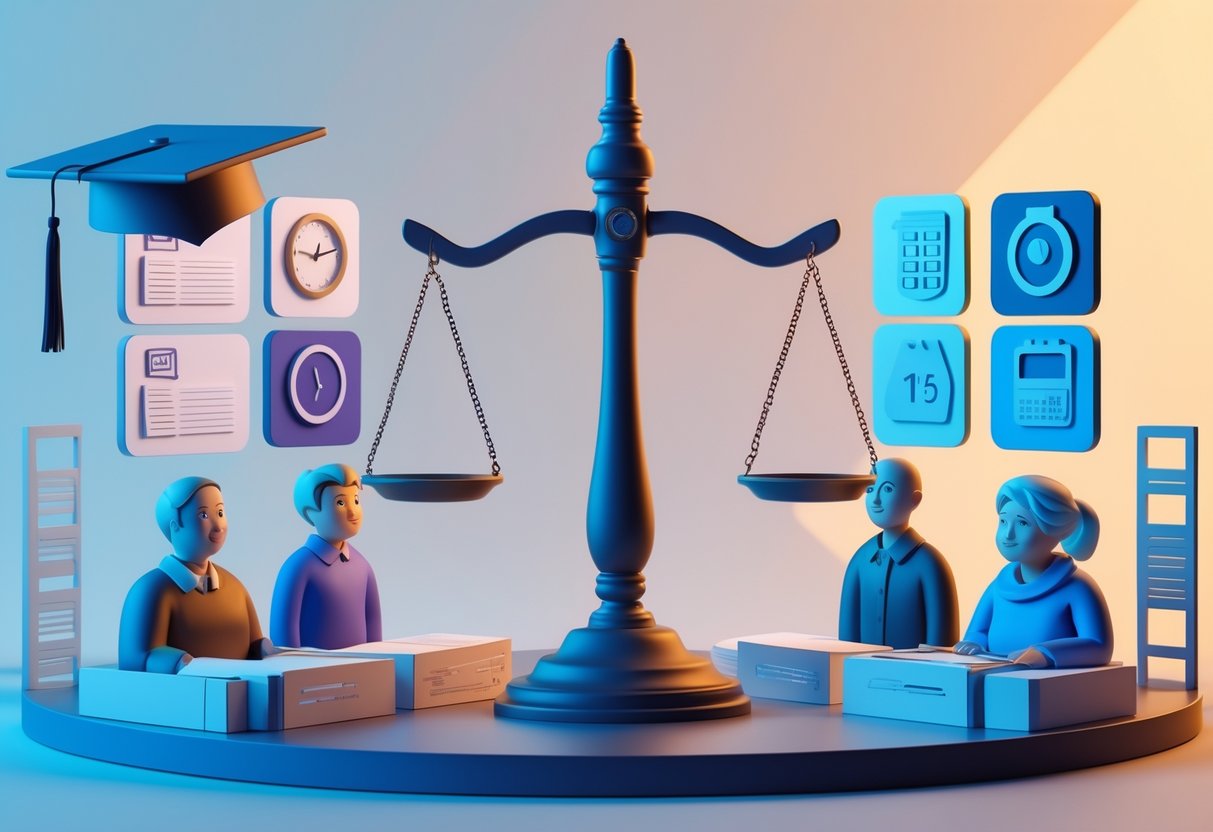
Age requirements can look wildly different depending on the situation. Some rules make sense for safety, but others just raise eyebrows about fairness. Most of these rules reflect society’s ideas about maturity and responsibility, not always real evidence about what people can handle.
Social Media and Online Platforms
Most social media sites set their minimum age at 13, following the Children’s Online Privacy Protection Act (COPRA) in the US. UK platforms usually go along with this, too.
Current age requirements include:
- Facebook, Instagram, TikTok: 13 years
- WhatsApp: 13 years (16 in the EU)
- LinkedIn: 13-16 depending on location
- Discord: 13 years
These rules try to protect kids’ privacy and stop companies from collecting their data. Still, enforcement is pretty weak across most platforms.
A lot of kids just lie about their age to sign up. Studies say up to 38% of kids under 13 use social media anyway.
The fairness debate gets messy:
Some people think 13-year-olds aren’t mature enough to handle online drama or privacy risks. Others argue that blanket age rules ignore how much kids can differ.
Parents sometimes want their kids on these platforms for educational reasons or family communication. That leads to a tug-of-war between parental rights and platform liability.
The digital divide matters, too. Kids from lower-income families might depend more on free social platforms for schoolwork or staying in touch.
Alcohol and Tobacco Laws
The UK has some of the world’s most tangled age rules for alcohol and tobacco. These laws come from years of public health research, but they’re tough to enforce.
Current UK requirements:
- Buy alcohol: 18 years
- Buy tobacco/vaping: 18 years
- Drink alcohol with a meal: 16 years (with an adult)
- Challenge 25: ID checks for anyone who looks under 25
The drinking age tries to balance freedom and public health. Research links earlier drinking to more alcohol problems and accidents.
But the rules can feel weird in real life. A 17-year-old can get married and have kids, but can’t buy wine for their own wedding.
Enforcement isn’t always fair:
Wealthier areas usually check IDs more strictly than poorer ones. That means access to age-restricted products can depend more on your postcode than your actual age.
Some young people from ethnic minorities say they get ID’d more often than white peers. That hints at unconscious bias in how we judge age.
Online shopping makes age checks even trickier. Some sites use real verification, but others just ask you to tick a box.
Political Office Age Limits
The UK sets minimum ages for political participation that some people think are outdated. These rules came in when people didn’t live as long and had fewer educational opportunities.
Current requirements include:
- Vote: 18 years
- Stand for local council: 18 years
- Stand for Parliament: 18 years
- Stand for Police and Crime Commissioner: 18 years
Other countries set higher minimums for top jobs. The US president must be 35, but France lets anyone 18 or older run for office.
Why lower the age limits?
Young people will live with political decisions the longest, especially on climate and the economy. Yet, they have the least say.
Some UK councils have elected great councillors in their teens and twenties. These cases challenge the idea that young people can’t handle politics.
Why keep the limits as they are?
Political jobs need tough decision-making skills that might come with age. Still, research shows mental abilities often peak before traditional retirement age.
The fairness talk also covers upper age limits. Some want mandatory retirement for politicians, though that opens another can of worms about discrimination.
Credit Transactions
UK credit laws put 18-year-olds in a strange spot. They’re legally adults, but often can’t get basic financial services without help or a credit history.
Key restrictions include:
- Credit cards: 18 years minimum
- Personal loans: usually 18, but lenders often want more income
- Mortgages: 18 years, but most lenders prefer over-21s
- Store credit: varies, but usually 18 years
These rules try to keep young people from racking up debt. But they also make it tough to build the credit history needed for future independence.
Fairness here gets complicated:
Students can struggle to get credit for real needs, like school costs. Sometimes they end up using high-interest payday loans or relying on family.
Kids from wealthier families can get parental guarantees. Those with fewer resources face more roadblocks to financial freedom.
Some new ideas are popping up:
A few lenders now look at things like utility bills or phone contracts to judge creditworthiness. That helps young people build a profile without a job history.
Schools are starting to offer financial education, but not everywhere. Access depends on where you live and what school you attend.
The rise of buy-now-pay-later services brings new worries about debt. These companies often have weaker age checks than banks.
Retirement Policies and Practices

Retirement policies look different everywhere. Some companies and countries enforce strict age limits, while others let people retire when they want. Balancing business needs with fair treatment for older workers isn’t easy, especially with age discrimination laws in play.
Mandatory Retirement Laws
Mandatory retirement ages are still legal in some cases, but tribunals are taking a closer look. Companies can only force retirement if they prove it’s for a real business reason.
The law says firms must show their retirement age is a “proportionate means of achieving a legitimate aim.” This could mean planning for the future or keeping team dynamics healthy. But courts want hard evidence, not just assumptions about older workers.
Key requirements for legal mandatory retirement:
- Clear business reasons with real data
- Regularly reviewing the policy
- Considering less discriminatory alternatives
- Keeping detailed records of decisions
A lot of companies struggle to meet these standards. In a recent case, Walker Morris LLP lost in court over forced retirement at 63. They couldn’t show older partners performed worse or blocked younger staff.
The tribunal said stereotypes about declining performance don’t cut it. Employers need actual performance data showing problems at specific ages.
Flexible Retirement Options
Some employers now offer flexible retirement, which helps everyone. These options cut down on discrimination risks and let experienced staff stick around longer.
Popular flexible options include:
- Phased retirement: Slowly cutting back hours over time
- Part-time transitions: Moving from full-time to fewer hours
- Project-based work: Bringing retirees back for special projects
- Mentoring roles: Having experienced folks train younger staff
A few companies let people work past the usual retirement age. But making older workers meet “exceptional performance” standards to stay can be discriminatory if those standards are higher than for others.
Open conversations about career plans work better than setting age limits. Regular chats help figure out when someone wants to retire, supporting both the worker and company planning.
Performance management should treat everyone the same, no matter their age. Using standard review processes to handle underperformance is fairer than blanket retirement rules.
Penalties and Enforcement of Age Restriction Laws
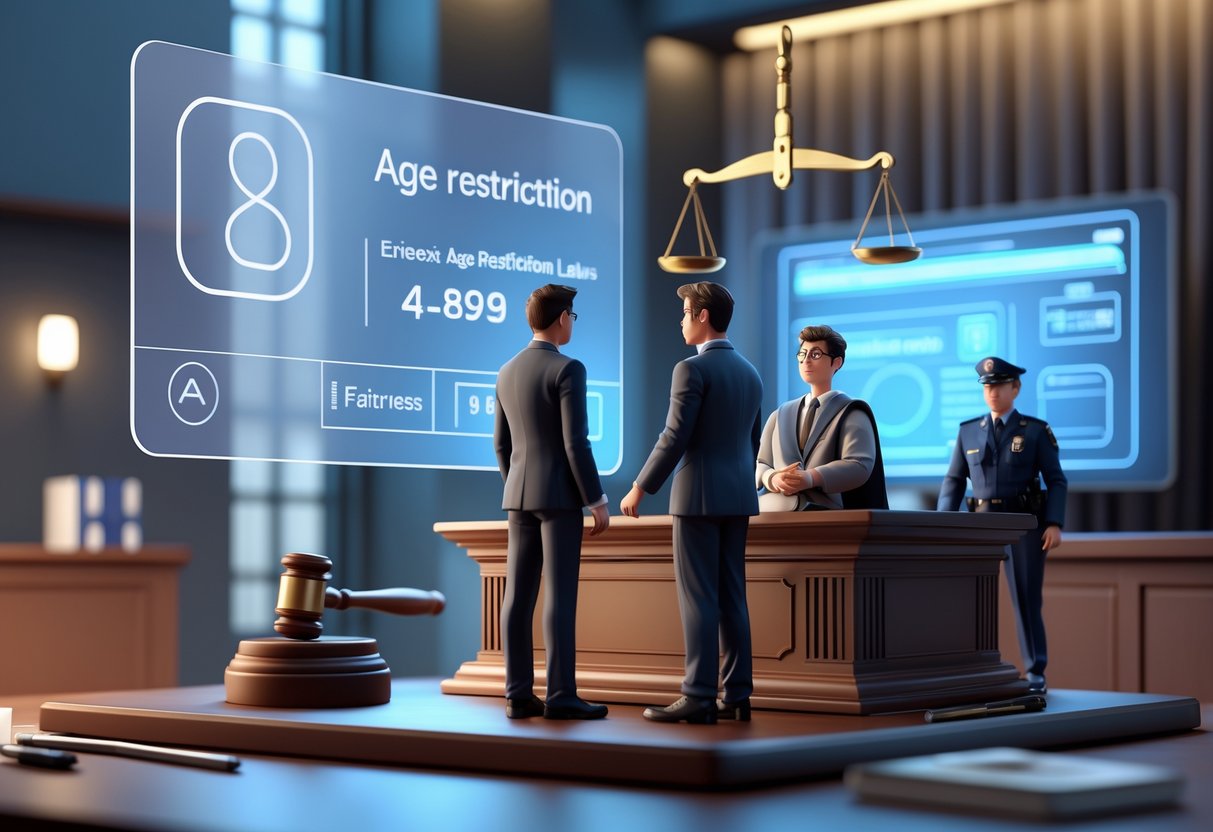
Breaking age restriction laws brings real financial and legal trouble. Government agencies keep an eye on compliance and can hand out fines from hundreds to thousands of pounds.
Warning Procedures and Fines
Most enforcement begins with warning procedures before things escalate to penalties. If a business violates the rules for the first time, they usually get a written notice.
First Violations:
- Written warning with a 30-day correction period
- Compliance review requirements
- Staff training mandates
Repeat Offences:
- Fines from £500 up to £20,000
- Temporary licence suspensions
- Mandatory compliance audits
Civil penalties can add up fast. Communities that discriminate based on age often pay more than just fines. They might also cover attorney fees and actual damages to the people affected.
Financial Impact Examples:
- Tobacco sales to minors: £2,500 fine per incident
- Alcohol violations: £1,000-£10,000 range
- Online age verification failures: Up to £18 million or 10% of annual turnover
Sometimes, businesses must pay impact fees that were previously waived. The total cost often ends up higher than the original fine.
Enforcement Agencies
Several agencies oversee age restriction compliance in different sectors. Each one focuses on specific areas and has its own powers.
Primary Enforcement Bodies:
- Local Trading Standards: Alcohol, tobacco, and retail sales
- Ofcom: Online platforms and digital services
- Department for Work and Pensions: Employment age restrictions
- Health and Safety Executive: Workplace safety for young workers
The Department of Labour deals with employment-related violations. They protect young workers from dangerous conditions and too many hours on the job.
Trading Standards officers carry out regular inspections using test purchases. They send young volunteers to try buying restricted items and keep an eye on compliance.
Inspection Methods:
- Unannounced site visits
- Mystery shopper programmes
- Complaint investigations
- Licence renewal audits
Digital enforcement has really picked up lately. Online platforms now face more scrutiny over age verification systems and content access.
Balancing Fairness with Legal Requirements
Trying to balance preventing discrimination with meeting business needs is a tricky business. Federal law sets the boundaries, so employers need to know when age restrictions are truly legal and when they’re just crossing the line.
Preventing Discrimination whilst Ensuring Compliance
The Age Discrimination in Employment Act (ADEA) protects workers aged 40 and up from unfair treatment. This law draws a clear line around what employers can and can’t do.
We shouldn’t use age as the main reason for hiring, firing, or promoting someone. Mandatory retirement policies are mostly off-limits unless they fit specific legal exceptions.
Permissible age restrictions need a real purpose:
- Safety requirements for physically demanding jobs
- Legal mandates (like minimum age for alcohol service)
- Bona fide occupational qualifications
Courts look closely at whether age limits actually fit the job’s needs. Broad age restrictions that block whole groups rarely make the cut.
Employers should write down the exact reasons for any age-related requirements. This documentation matters if someone files a discrimination claim.
Reasonable Factors Other Than Age
Federal law lets employers base decisions on reasonable factors other than age (RFOA). These factors offer legal alternatives to age-based rules.
Valid alternatives include:
- Skills assessments and competency tests
- Physical fitness requirements tied to job duties
- Technology proficiency standards
- Educational qualifications
We need to make sure these factors really connect to job performance, not just cover up age discrimination. If a tech requirement hits older workers harder, there has to be a solid business reason.
Training programmes can bridge skill gaps instead of just setting age limits. This way, companies stay compliant and keep their standards up.
Performance reviews should focus on what people actually achieve, not on age-based assumptions. Regular, objective reviews protect better than blanket age policies.
Recent Developments and Future Trends
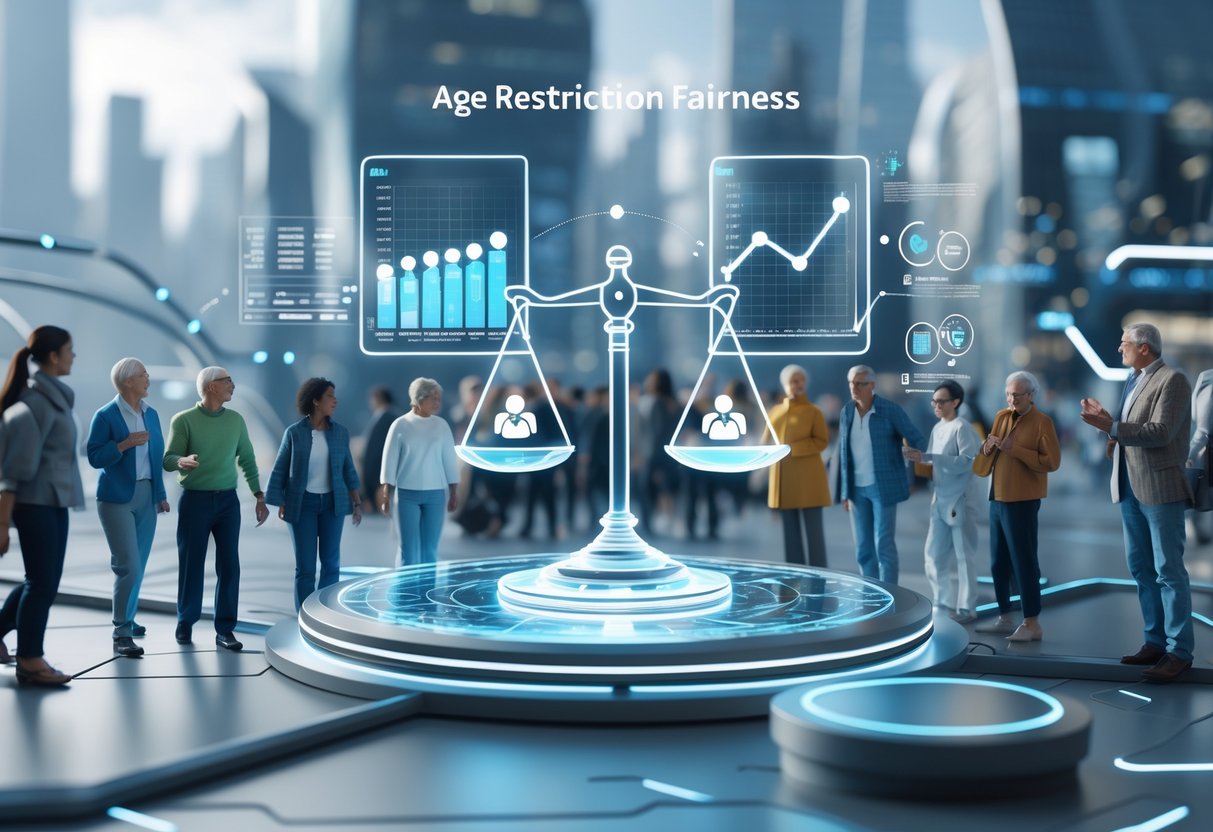
Courts now challenge age-based restrictions more often, especially when there’s no clear reason for them. New state laws have started to expand protections beyond the federal minimums.
State-Level Reforms
Some states have gone further than federal law to protect against age discrimination. California, for example, now bans age-based hiring preferences even for workers under 40, closing a gap in the ADEA.
New York has made it tougher for employers to justify age-based job requirements. The state demands documented evidence when age is a factor.
Key state changes include:
- Protected age ranges now cover all ages in some states
- Stricter documentation for age-justified roles
- Harsher penalties for discrimination
- Mandatory bias training for hiring managers
Massachusetts recently got rid of most mandatory retirement ages for public sector jobs. This move shows how blanket age restrictions rarely hold up anymore.
Several states are also reviewing licensing rules that set upper age limits. Medical and legal fields, in particular, are under scrutiny for policies that could shut out older professionals.
Evolving Workplace Policies
Big employers are moving away from age-based thinking and focusing on skills. Legal pressure and an ageing workforce are driving this shift.
Modern workplace approaches include:
- Skills assessments instead of age proxies
- Flexible retirement options, not mandatory ages
- Age-blind recruitment processes
- Mentorship programmes that mix generations
Tech companies lead the way here. IBM and Google, for instance, removed age preferences from job postings after legal trouble.
Physical fitness requirements now match job demands, not just age. Police and fire departments use task-specific tests to measure actual ability.
Remote work has sped up these changes. When performance is easy to measure, age stereotypes start to fade.
HR teams are putting more effort into reasonable adjustments for all ages. Flexible schedules and updated equipment help everyone, not just older workers.
Resources and Further Guidance

Government agencies offer clear guidelines on age restriction laws. Employers and workers can find practical tools to understand their rights and responsibilities. These resources make it easier to build fair workplaces.
Support from Government Agencies
The Department of Labor posts detailed guidance on age discrimination laws on its website. They share fact sheets explaining when age restrictions are legal and when they’re not.
Their resources cover how to file a complaint if you face unfair age treatment. You can also find info about the Age Discrimination in Employment Act (ADEA), which protects workers aged 40 and up.
ACAS (Advisory, Conciliation and Arbitration Service) gives free advice on age discrimination at work in the UK. They provide:
- Phone helplines for quick help
- Face-to-face consultations
- Mediation services for employers and employees
Local employment tribunals publish annual reports with common age discrimination cases. These reports help you see what courts consider unfair treatment.
Educational Tools for Employers and Employees
Training programmes from professional groups show managers how to create age-inclusive policies. Many offer online courses that explain legal requirements and best practices.
The Equality and Human Rights Commission gives out free toolkits for businesses. These include policy templates, interview question guides, and recruitment checklists that avoid age bias.
Trade unions often release guides tailored to specific industries. They explain your rights in plain English and offer support if you need to challenge unfair age rules.
Online legal databases like Westlaw and LexisNexis have case studies about age restriction disputes. Many libraries let you access these for free.
Frequently Asked Questions

Age discrimination laws protect workers aged 40 and up from unfair treatment because of their age. Knowing how to spot discrimination, gather evidence, and understand your rights can help you handle workplace challenges and take action if needed.
What are the indications that you might be facing age discrimination at work?
Age discrimination often pops up as comments about your age or retirement plans. Colleagues might joke about being “over the hill” or hint that you’re behind on tech.
You could find yourself left out of training or meetings. Sometimes, younger workers get promotions or assignments you’re more qualified for.
Warning: Subtle signs include questions about retirement or doubts about your computer skills with no real reason.
Your employer might change your role to cut your responsibilities. They might also push you to take early retirement or redundancy.
When people talk about needing “fresh blood” or “young energy,” that’s usually code for age bias. These phrases often hide discriminatory attitudes.
How can one successfully prove age discrimination in a legal case?
Documentation is everything in an age discrimination case. Keep records of comments, emails, and incidents, including dates and witnesses.
Hang on to performance reviews that show you’re doing good work. This helps prove decisions weren’t really about performance.
Testimony from colleagues can really help your case. If co-workers heard discriminatory remarks or saw unfair treatment, get their support.
Statistical evidence about hiring and firing patterns can point to age bias. If your employer always promotes younger people or lays off older ones, that’s a red flag.
Quick tip: Start a private journal to log incidents as they happen. Fresh details are easier to remember than trying to piece things together months later.
What specific actions are considered unlawful under the Age Discrimination in Employment Act?
Refusing to hire someone because of their age breaks the law. Employers can’t use age as a reason not to recruit workers over 40.
Firing someone just because they’re older is illegal. Companies can’t replace older workers with younger, cheaper ones for that reason alone.
Age-based harassment creates a hostile work environment. This includes jokes, retirement comments, or treating older workers differently.
Denying promotions or training because of age isn’t allowed. Older workers must have equal access to career advancement and skill development.
Forcing retirement before age 70 is usually not allowed. Employers can’t pressure older workers to retire unless there’s a specific legal exemption.
In what ways are employees over the age of 55 protected from age-related unfair treatment?
Workers over 55 get the same protections as anyone 40 or older. The Age Discrimination in Employment Act covers hiring, firing, promotions, and workplace conditions for all.
Redundancy selections have to use fair criteria, not age. Employers can’t target older workers for layoffs.
Training and development should be open to older workers. Companies can’t block employees from learning programmes because of age.
Quick win: Remember, these protections apply whether you’re 42 or 62—the law treats all workers over 40 the same.
Pension and benefits can’t be cut just because of age. Older workers deserve the same access to company benefits and retirement support.
Can you give some common examples where age discrimination is evident in the workplace?
Job ads looking for “digital natives” or “recent graduates” often push out older workers. These phrases are a form of age bias.
If a company restructuring mostly affects older, higher-paid workers, that’s suspicious. Layoffs targeting people near retirement age look bad.
Comments about “keeping up with the times” or needing “fresh perspectives” can be ageist. They unfairly paint older workers as out of touch.
Leaving older workers out of team activities or networks creates isolation. Sometimes, social exclusion is as damaging as official policies.
Warning: If long-serving older workers suddenly get put on performance plans, it could be a sign of discrimination.
What steps should one take if they feel they’ve been a victim of age discrimination?
Start by reporting the discrimination to your HR department. Make sure you follow your company’s internal complaints process, and hang on to copies of any paperwork you submit.
You can reach out to ACAS (Advisory, Conciliation and Arbitration Service) for free advice. They offer guidance on employment rights and can help you with early conciliation.
If you need to take things further, file a complaint with an employment tribunal within three months of the incident. Remember, you usually have to go through early conciliation with ACAS before you can bring your case to tribunal.
Consider talking to an employment solicitor who handles discrimination cases. Quite a few offer a free initial chat to help you figure out if your claim stands a good chance.
Quick tip: Try not to resign right away—leaving could actually make your case harder to prove. If you feel like you can’t stay, get legal advice about constructive dismissal first.

